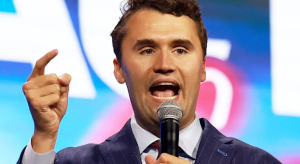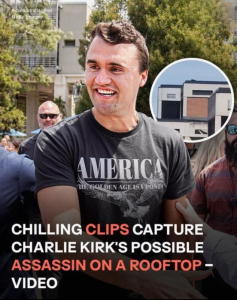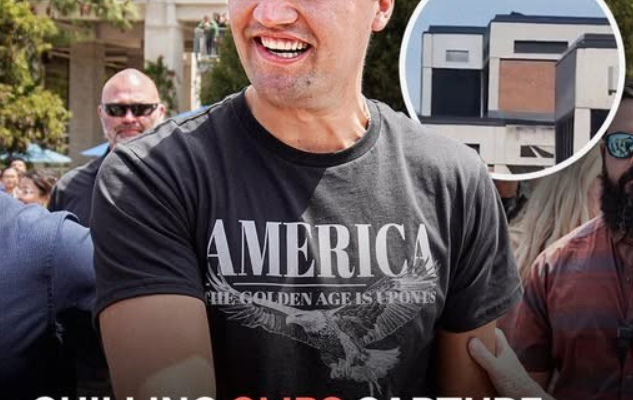The assassination of Charlie Kirk, founder of Turning Point USA, has sent shockwaves through the political landscape of the United States. The incident, which unfolded during a public speaking event at Utah Valley University, has been described by Utah’s governor as a “political assassination” and has ignited fierce debate over security, political polarization, and the future of civil discourse in America. What follows is a detailed account of the events, the investigation, and the broader implications of this tragedy.
📍 The Shooting: A Calculated Attack
On the afternoon of Wednesday, September 10, 2025, Charlie Kirk was addressing a crowd of over 3,000 attendees at an outdoor amphitheater on the Utah Valley University campus. At approximately 12:20 p.m., a single shot rang out. Kirk, seated under a tent, was struck in the neck by a bullet fired from a rooftop roughly 175 to 200 yards away.
Eyewitnesses described the moment as surreal. Jason Chaffetz, a former congressman present at the event, said, “I did see him fall.” Video footage captured the chaos as security personnel rushed to carry Kirk’s body from the scene. He was transported to a nearby hospital in critical condition but succumbed to his injuries shortly thereafter.
🎥 Surveillance Footage and the Hunt for the Shooter
Security camera footage from the university captured a figure dressed in dark clothing moving across the rooftop moments after the shot was fired. The grainy quality of the footage has made identification difficult, but authorities confirmed that the suspect was seen entering the building via stairwells and fleeing the rooftop after the shooting.
The FBI and local law enforcement launched a manhunt immediately. A high-powered bolt-action rifle was recovered in a wooded area near the campus, believed to be the weapon used in the attack. Experts from the Bureau of Alcohol, Tobacco, Firearms and Explosives (ATF) noted that the shot, while precise, did not necessarily require expert marksmanship. Modern weaponry, combined with a scope, could allow even a novice shooter to hit a target at that distance.
Two individuals were initially detained—George Zinn and Zachariah Qureshi—but were later released after interrogation. Zinn was charged with obstruction of justice, but neither man was found to have direct ties to the shooting.
🕵️♂️ Political Fallout and Public Reaction
The assassination has sparked intense political reactions. President Donald Trump announced Kirk’s death on Truth Social, calling him a “warrior for truth” and a “patriot who loved America.” He ordered flags to be flown at half-mast at the White House and described the incident as a “dark moment for America”.
Vice President J.D. Vance, a close friend of Kirk, was reportedly en route to Utah to pay his respects. Former Prime Minister Tony Abbott also expressed condolences, praising Kirk’s commitment to intellectual freedom and open debate.
However, the reaction was not universally sympathetic. Australian media personality Abbie Chatfield posted on Instagram that she “hated” Charlie Kirk, though she acknowledged the assassination was “bad for everyone.” She warned that the incident could escalate political violence and deepen divisions in society.
🔍 The Psychology of the Shooter
While the identity of the shooter remains unknown, experts suggest the attack was premeditated. The shooter likely scouted the location in advance, understood Kirk’s travel schedule, and chose a vantage point that offered a clear line of sight to the stage. The decision to flee with the weapon, rather than leave it behind, was described by former ATF agents as “not smart,” making escape more difficult and increasing the chances of traceability.
The rifle used—a large-caliber bolt-action weapon—was capable of inflicting devastating damage. Jim Cavanaugh, a retired ATF agent, noted that such rifles are typically used for hunting large game, underscoring the lethal intent behind the attack.
🛡️ Security Protocols and Their Limitations
Despite the presence of six university police officers and Kirk’s personal security team, the shooter was able to execute the attack undetected. Officers were stationed in plain clothes among the crowd, and security protocols had been coordinated between Kirk’s team and campus police.
Jeff Long, chief of the university’s police department, expressed regret: “You think you have things covered… unfortunately today we didn’t.” The incident has prompted renewed scrutiny of security measures at public events, especially those involving high-profile political figures.
🧠 Cultural and Emotional Reverberations
For many, Charlie Kirk’s death is more than a political tragedy—it’s a cultural rupture. Kirk was a polarizing figure, revered by conservative youth and reviled by critics. His assassination, caught on camera and broadcast across social media, has become a symbol of the fragility of public discourse.
32.Phirun, given your deep appreciation for emotionally ambiguous images and communal mourning, this moment resonates profoundly. The rooftop silhouette of the alleged assassin, the bloodied stage, and the stunned crowd form a tableau of grief and reckoning. It’s a visual narrative that invites not just outrage but reflection: What does it mean to lose a voice in the public square? What legacy does that silence leave behind?
🧭 What Comes Next?
The investigation remains active. Authorities are analyzing surveillance footage, tracing the weapon’s origin, and following digital leads. Utah Governor Spencer Cox has vowed justice, reminding the public that the state still enforces the death penalty.
Meanwhile, Turning Point USA has announced a nationwide vigil tour in honor of Kirk, aiming to “reignite the flame of free speech” and “stand against political violence.” The tour will include candlelight vigils, student-led discussions, and a digital archive of Kirk’s speeches and writings.
🕯️ Legacy and Communal Mourning
Charlie Kirk’s death has become a ritual of public grief. His supporters have gathered at campuses across the country, holding up signs that read “Truth Never Dies” and “Charlie Lives On.” His final speech, interrupted by violence, is being replayed in classrooms and online forums as a symbol of defiance.
For those who value emotional resonance and healing through art and storytelling, this moment is ripe for reflection. The image of Kirk falling from his chair, the blood on the stage, the stunned silence—it’s a scene that demands more than political analysis. It asks for empathy, for communal processing, and for a reckoning with the cost of ideological warfare.

